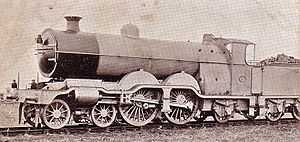LB&SCR H1 class
| LB&SCR H1 class | |
|---|---|
|
Official photograph of No.37 shortly after delivery in 1905. | |
| Type and origin | |
| Power type | Steam |
| Designer | D. E. Marsh |
| Builder | Kitson & Co. |
| Build date | 1905–1906 |
| Total produced | 5 |
| Specifications | |
| Configuration | 4-4-2 |
| Gauge | 4 ft 8 1⁄2 in (1,435 mm) |
| Leading wheel diameter | 3 ft 6 in (1.067 m) |
| Driver diameter | 6 ft 7 1⁄2 in (2.019 m) |
| Locomotive and tender combined weight | 106 long tons 5 cwt (238,000 lb or 108.0 t) |
| Fuel type | Coal |
| Boiler pressure | 200 psi (1.38 MPa) |
| Cylinders | Two, outside |
| Cylinder size | 18.5 in × 26 in (470 mm × 660 mm) |
| Performance figures | |
| Tractive effort | 19,028 lbf (84.6 kN) |
| Career | |
| Class | H1 |
| Power class | BR: 3P |
| Withdrawn | 1944–1951 |
| Disposition | All scrapped |
The London, Brighton and South Coast Railway H1 class was a class of 4-4-2 steam locomotives for express passenger work. They were designed by D. E. Marsh and were built by Messrs Kitson & Co. in 1905 and 1906.
History
Prior to taking up office as the Locomotive Superintendent of the London, Brighton and South Coast Railway in 1905, Douglas Earle Marsh had worked for the Great Northern Railway at Doncaster Works. There he had been involved in the design of the Klondyke class designed by Henry Ivatt in 1897. There was an urgent need for new large express passenger locomotives for the LB&SCR and so he obtained a set of drawings from Doncaster, and made only detailed amendments before ordering them from the manufacturer. He did however increase the boiler pressure from 175 to 200 pounds per square inch (1.21 to 1.38 MPa).
Performance
The class soon proved to be successful working the London to Brighton express trains including the heavily loaded Pullman services the "Brighton Limited", and The Southern Belle, which the LB&SCR described as "the most luxurious train in the World".
Superheating
In May 1920 L. B. Billinton wished to install the Schmidt superheater to improve the efficiency of the class, but was refused permission to do so by the Brighton Locomotive Committee. This modification was however carried out by Richard Maunsell of the Southern Railway during 1925–1926 after the "Grouping" of 1923.
Re-allocation and naming
.jpg)
During 1925 and 1926 the H1 class were gradually replaced on the London-Brighton express trains by the "King Arthur" and "River" classes, but there was still plenty of work for them on other express services, including the boat trains connecting with the Newhaven-Dieppe ferry service. At the same time they were all named after geographical features of the south coast.
Withdrawal
Following the cessation of the cross-channel ferries after 1940, as a result of the Second World War the class were left with little work to do and several were put into store or else moved to miscellaneous duties in southern England, and the first members of the class were withdrawn in 1944.
In July 1947 No. 2039 was experimentally rebuilt with sleeve valves by Oliver Bulleid as a mobile test bed in preparation for his Leader class locomotives. It was never returned to its original state and in common with the remainder of the class had been withdrawn by 1951. None have survived.
Locomotive Summary
| LB&SC Number | Built | S.R. Number | Name | B.R. Number | Withdrawal |
|---|---|---|---|---|---|
| 37 | December 1905 | 2037 | Selsey Bill | 32037 | July 1951 |
| 38 | December 1905 | 2038 | Portland Bill | 32038 | July 1951 |
| 39 | January 1906 | 2039 | Hartland Point | 32039 | February 1951 |
| 40 | February 1906 | 2040 | St Catherine's Point | — | January 1944 |
| 41 | February 1906 | 2041 | Peveril Point | — | March 1944 |
References
- Bradley, D.L. (1974). Locomotives of the London Brighton and South Coast Railway. Part 3. Railway Correspondence and Travel Society.
External links
| Wikimedia Commons has media related to LB&SCR H1 class. |
| ||||||||||||||||||||||||||
